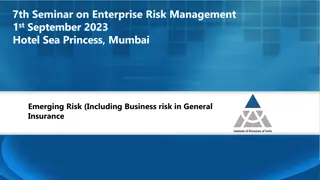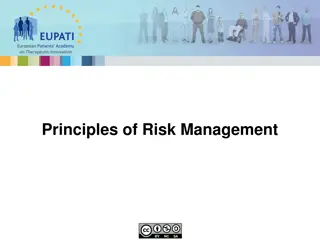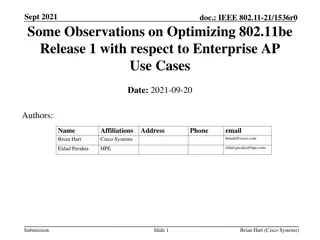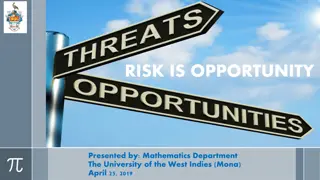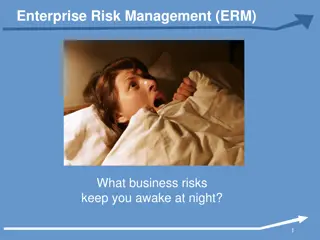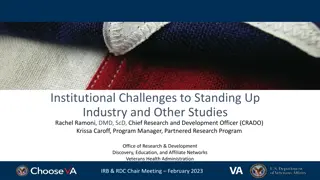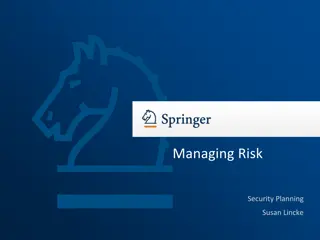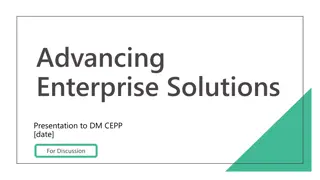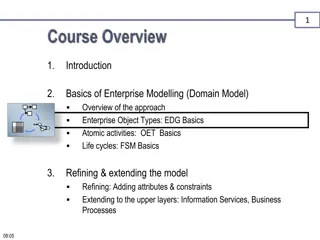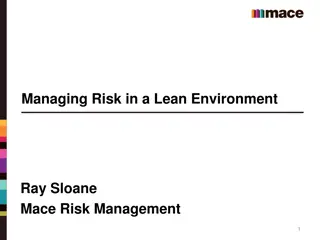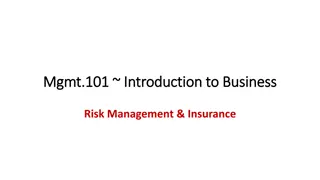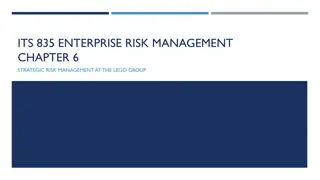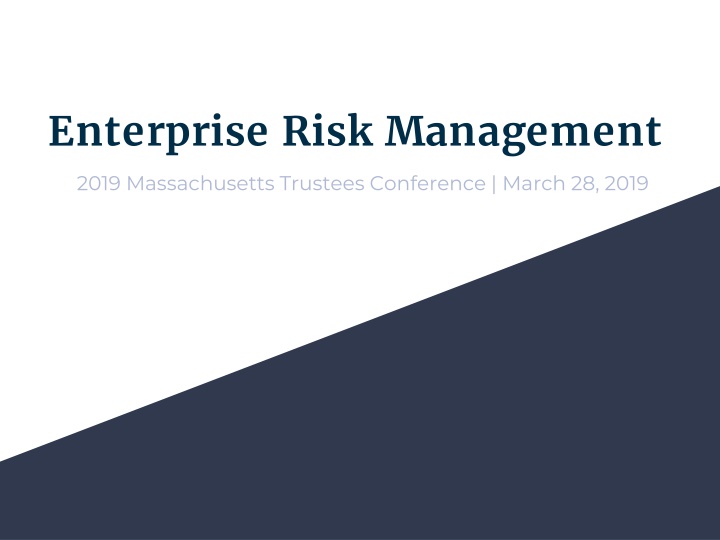
Enterprise Risk Management at Massachusetts Trustees Conference 2019
Learn about Enterprise Risk Management (ERM) from the Massachusetts Trustees Conference 2019, where senior leadership discusses identifying, assessing, developing response plans, and monitoring risks across the enterprise.
Download Presentation

Please find below an Image/Link to download the presentation.
The content on the website is provided AS IS for your information and personal use only. It may not be sold, licensed, or shared on other websites without obtaining consent from the author. If you encounter any issues during the download, it is possible that the publisher has removed the file from their server.
You are allowed to download the files provided on this website for personal or commercial use, subject to the condition that they are used lawfully. All files are the property of their respective owners.
The content on the website is provided AS IS for your information and personal use only. It may not be sold, licensed, or shared on other websites without obtaining consent from the author.
E N D
Presentation Transcript
Enterprise Risk Management 2019 Massachusetts Trustees Conference | March 28, 2019
Panel Introductions Amanda Robbins: CSVP Advisor, Department of Higher Education Patricia Gentile: President, North Shore Community College Kevin Foley: Board of Trustees, Framingham State Linda Snyder: Board of Trustees, MassArt 2
Introductions Summary of Presentation Overview of Enterprise Risk Management (ERM) Panel Discussion Questions & Answers 3
Enterprise Risk Management A practical definition of ERM from Risk Management: An Accountability Guide for University and College Boards (AGB Press, 2013): ERM is a business process led by senior leadership that extends the concepts of risk management and includes: Identifying risks across the entire enterprise Assessing the impact of risks to the operations and mission Developing and practicing response or mitigation plans Monitoring the identified risks, holding the risk owner accountable, and consistently scanning for emerging risks 4
Risk Management Process Risk Implementation Plan Operational Analysis Vulnerability Assessment Reduction Solutions 5
Identify Assets: People Physical Property Reputation Intellectual Property Proprietary Information Operational Analysis 6
Understanding Risk: Identify the threats and hazards that may affect your organization Vulnerability Assessment Determine the likelihood of occurrence and impact if a threat or hazard were to occur Evaluate current countermeasures in place to mitigate risk 7
Risks Impacting Higher Education Traditional Operational Risk weather, active threats, fire, strike, accident Legal and Regulatory Risk litigation by staff and/or students Financial Risk drop in enrollment, decline in govt support, failed fundraising Political and Reputational Risk loss of accreditation, govt sanctions, negative PR 8
Based on the results of the operational analysis and vulnerability assessment, identify gaps and vulnerabilities Risk Apply industry standards and best practices to develop risk reduction solutions to close gaps Reduction Solutions Focus on prevention, protection, mitigation, response, recovery Include physical, procedural, staffing, training, redundancy and technological risk reduction solutions 9
Implementation Plan Phased implementation plans/timeline ~ Budget analysis and ROM pricing 10
Strategic Risk Management Plan 1-5 year Risk Management Master Plan Based on real-life vulnerabilities and risk based solutions Associated costs included Priorities weighed and set in a comprehensive and clear manner Easy to understand and justify to leadership Since it is a multi-year plan, performance metrics are essentially already built in Revisit your plan annually or every 2 years to adjust as needed and to show progress 11
Addressing Risk at Institutions in MA Higher Education is different: Campus safety and violence prevention demands must be balanced with the overall philosophy of institutions of higher education. Campuses are quite different from airports or federal buildings. Their openness makes them, inevitably, soft targets but for all the right reasons: a desire to remain open to a wide variety of individuals, ideas, and even disagreements. Any safety and security apparatus must focus on minimizing risks and maximizing defenses to protect the community, but must also maintain the special status these institutions have in our society. Governance is key: The necessity of providing safe and secure environments goes well beyond tactical or procedural requirements. A number of the report s recommendations focus instead on providing guidance on the best governance structures at the system, segmental, and institutional level that can provide coordinated approaches to protect the wellness of our communities. Ownership must be shared: The silos that exist between those charged with campus safety and violence prevention either traditional law enforcement or staff involved with sexual violence complaints and the leadership structures of each institution continue to persist. Safety and security, to be effective, must be owned by the entire community. Engagement and support from the institution s leadership: Some of the most successful initiatives and programs at the institutions visited were incorporated into the school s overall strategic plan for campus safety and violence prevention. Being elevated to this level was a direct result of an Administration and/or Board of Trustees that fully support and/or have an active role in guiding these efforts. Too often it is sidelined from the core planning; it must be elevated and recognized as a shared responsibility. 12
Current State of Enterprise Risk Management Sample of AGB/UE Survey Results: In 2013, 45% of respondents strongly agreed that ERM is a priority at their institution compared to 2008 (41% mostly agreed ) But, in many cases, institutions are not following any formal risk assessment processes - 39% of respondents say their institution has conducted an ERM process in the last 2 years (61% have not) 62% of respondents in 2013 report that the full board is engaged in risk discussions (up from 47% in 2008) and discussions are occurring across a greater number of board committees However, 60% of respondents reported that the risk information boards receive particularly about financial risks is adequate, only 39% strongly agreed that enough risk information is shared to fulfill their legal and fiduciary duties *A Wake-up Call: Enterprise Risk Management at Colleges and Universities Today. A Survey by the Association of Governing Boards of Universities and Colleges and United Educators 13
Trustee Engagement: 2016 Task Force Recommendations Finding: Strategic Planning Process at the Institution Level Campus safety and violence prevention should be incorporated into each institution s strategic planning process. Engagement at the institution level should include buy-in and commitment from the Board of Trustees as well as Senior Leadership. Too often it is sidelined from the core planning; it must be elevated and recognized as a shared responsibility. Recommendation: Elevate Board of Trustees Engagement The Board of Trustees for each institution carries a level of responsibility for managing and mitigating risks, as an important part of their overall fiduciary duty. Trustees need to be engaged in some level of oversight through the higher level strategic planning process to help make critical decisions related to initiatives and budget priorities. To this end, Trustees are encouraged to form campus safety and violence prevention committees, and receive regular updates on applicable issues, to enhance accountability for the quality of campus life at all levels of the institution. 14
Board Responsibility: AGB Recommendations The Board s responsibility for risk management has four components: Establishing ERM as an institutional priority Considering the institution s tolerance for risk Calling on senior administrators to establish a process for identifying, prioritizing and monitoring risk, with formal assignment of responsibility for risk assessment and management to an appropriate individual or office Monitoring the plan s implementation through regular, formal reporting to the board or an appropriate board committee by the appropriate senior administrator. 15
Panel Discussion Panelists: Patricia Gentile, President, North Shore Community College Kevin Foley, Board of Trustees, Framingham State Linda Snyder, Board of Trustees, MassArt Questions for the audience to consider: How frequently is institutional risk discussed at board meetings? What are the key risks facing your institution? How often are risk management plans updated and presented to the board? If your campus conducts/has conducted campus climate surveys, how does the data obtained affect the risk management process? 16
Questions and Conference Survey Amanda Botelho Robbins Advisor, Campus Safety and Violence Prevention MA Dept of Higher Education arobbins@dhe.mass.edu Please fill out the conference survey: https://www.surveymonkey.com/r/2019Trustees 17


